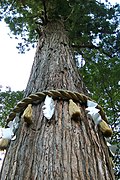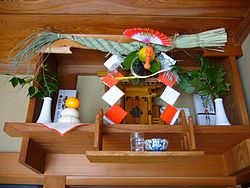Shimenawa
lengths of laid rice straw or hemp rope used for ritual purification in the Shinto religion From Wikipedia, the free encyclopedia
Remove ads
Shimenawa (標縄/注連縄/七五三縄, lit. 'enclosing rope') are ropes [1] used for ritual purification in the Shinto religion.
This article may be expanded with text translated from the corresponding article in English. Click [expand] for important translation instructions.
|
Shimenawa come in different sizes, ranging from a few centimeters to several meters in diameter, and are often adorned with shide, which are traditional paper streamers. When a space is enclosed by shimenawa, it is considered sacred or ritually pure, such as in a Shinto shrine.[2] Shimenawa are believed to ward off evil spirits and are commonly used in Jichinsai before constructing new buildings. They are also commonly found at Shinto shrines, torii gates, and other sacred landmarks.
Shimenawa, are also placed on objects believed to attract spirits or be inhabited by them, known as yorishiro. This includes trees called shinboku, with the spirits believed to inhabit them known as kodama. Cutting down these trees is considered to bring misfortune. Similarly, stones believed to be inhabited by spirits are known as iwakura (磐座/岩座).[3]
Remove ads
Image gallery
Related pages
References
Further reading
Other websites
Wikiwand - on
Seamless Wikipedia browsing. On steroids.
Remove ads










